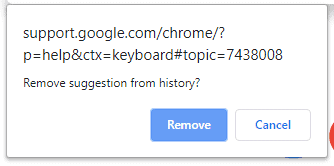

Note if you use Chrome in Incognito Mode when browsing sites, then visited URLs and links will not be stored or suggested this way. No more accidental links showing up was recommended constantly, embarrassing URLs, typo links, unwanted suggestions, exposed secrets, or whatever else you wish to remove out. Now you can clear out any unwanted links or URLs from your Chrome search suggestions using this approach. This method works in all Chrome browsers whether on Mac, Windows, Chromebook, or Linux.

On the latest versions of Chrome, you can also use the keyboard to navigate to the URL/link to delete from the suggestion list, then click the “X” button that appears to the far right of the search bar next to the entry. Repeat with other URL/link suggestions as desired.The highlighted URL/link will immediately be deleted.With the link/URL highlighted, use e keystroke to delete that URL/link from the suggestion list.Use the keyboard to navigate to the URL/link you’d like to remove from the pop-up suggestion list.Open the Chrome browser and start typing the URL or link that you wish to remove, for example “”.Here is how you can delete any past suggested link or URL that shows up when typing in the Chrome address bar: How to Remove Past Link/URL from Google Chrome Address Bar We’ll cover how this works on the Mac, Windows PC, and Chromebook. Hopefully, this guide will help you completely remove Google Chrome and its associated files from your macOS device.This is handled separately from clearing out Chrome history and other browsing data, but if you’re familiar with deleting Chrome autofill suggestions for other text input boxes in the browser, this may be a familiar process to you. Note: The number of files and folders present in the directory will vary on personal use.Īnd that’s it, people, uninstalling Google Chrome from your macOS device is that easy. Once selected, press the Command+ Delete keys together on your keyboard to permanently delete all the files from your macOS device. Now, select all folders present in the directory by pressing Command+ A keys together on your keyboard. ~/Library/Application Support/Google/Chrome This will open a Finder window to the specified directory. Now, copy+paste or enter the below-mentioned address in the space provided and press Return on your keyboard or press the ‘Go’ button to proceed. Alternatively, you can also press the Shift+ Command+ G keys together on your keyboard to open the window. Next, locate and click on the ‘Go to Folder’ option to continue. Once entered, click on the ‘Uninstall’ button to remove it from your device.Īfter that, click on the ‘Go’ tab present in the menu bar to reveal an overflow menu. Since you are uninstalling an app, you might be prompted to enter your device password. Then, click to select the ‘Move to Trash’ option to proceed. Next, from the right section of the window, locate and right-click on the Google Chrome app. Alternatively, you can also press the Command+ N keys together on your keyboard to open a new Finder window.Īfter that, on the Finder window, click on the ‘Applications’ tab present on the left sidebar to continue. The rest of the supporting files can be deleted by using the Finder.įirst, to uninstall the Chrome app, double-click on the Finder app present on your dock. On any macOS device, uninstalling Chrome translates to simply heading to the ‘Applications’ folder on your device and sending it to the ‘Trash’. Send Chrome App to Trash and Delete Supporting Files Hence, this guide will properly apprise you on how to effectively uninstall Google Chrome from your macOS device. However, irrespective of if you are using macOS for quite some time or you have just recently made the switch to it, many tend to forget to remove the supporting files that usually store your bookmarks, profile information, and browsing history as well. In fact, the process is so simple it hardly takes a minute to uninstall Chrome from your macOS device. Uninstalling Google Chrome is a very straightforward and simple process. A simple, step-by-step guide to uninstall Google Chrome and its support files completely from your macOS device.


 0 kommentar(er)
0 kommentar(er)
